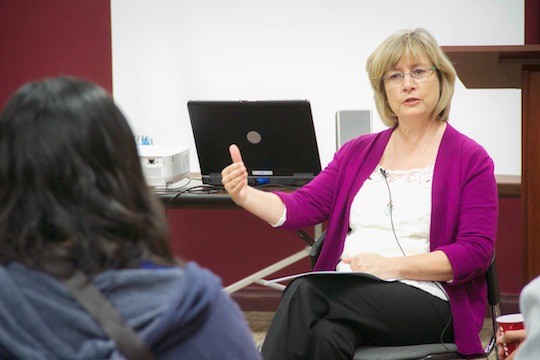
NAC Students Learn How to Find Happiness at Chapman Lecture with Dr. Gail Stearns
The final presentation of the Chapman Visiting Scholars Series in 2013 ended the year on a happy note. On Saturday, December 14, in a presentation entitled, “How to Find Happiness,” Dr. Gail Stearns, Dean of the Wallace All Faiths Chapel and Associate Professor of Religious Studies at Chapman University, engaged students in a variety of exercises, each one designed to make them more mindful and aware of the present. According to Dr. Stearns, new research suggests that learning to be mindful and present brings greater happiness and contentment.
Dr. Stearns admitted during the lecture that while it’s unlikely anyone will find themselves completely happy all of the time, they can at least practice a few simple exercises aimed at anchoring themselves in the moment, releasing unnecessary stress and increasing happiness.
To help students find happiness, or at least temporarily lower their stress level, Dr. Stearns suggested they STOP: Stop, Take a breath, Observe, and Proceed. Focused breathing, a common “anchor” used in mindfulness practices, allows the body to relax while it reduces the “noise” caused by scattered thoughts. Dr. Stearns claimed that people who do not “live in the present” instead live in a “story.” She went on to explain, “We create these stories, but the other thing that happens is we tend to move towards the negative, and there’s a lot of evidence showing that we tend to think more negatively than positively when we’re projecting ahead.”
To better illustrate the effectiveness of the STOP exercise, Dr. Stearns asked students to hold either a piece of chocolate or a raisin in their hand. Then, with their eyes closed, students were asked to focus on the weight and feel of the object, noting the texture of its surface, as well as its scent. When students were instructed to eat the chocolate or raisin, they were also asked to focus on the flavor and note whether it lingered or not. NAC student Gabriel Piñon remarked, “I didn’t realize that when we eat our food there’s so much going on.” Other students shared that the raisin had more flavor than they anticipated, to which Dr. Stearns replied, “One of the things that happens when you’re present is that it’s like life is just richer.”
In addition to increasing one’s happiness, the ability to focus also allows people to work more effectively. To demonstrate, Dr. Stearns asked students to write the alphabet in one column on a piece of paper, and then write the numbers 1-26 in a second column. Then, on the opposite side of the paper, students were asked to write the letters & numbers consecutively (A, 1, B, 2, C, 3, etc.). Most students finished the single columns more quickly than the mixed column; the latter assignment forced students to multitask, writing numbers and letters as opposed to just writing one or the other. The exercise showed that it is harder to be mindful when multitasking.
Later, students watched a video, “The Science of Happiness: An Experiment in Gratitude,” from soulpancake.com. The video looked at people’s responses to giving gratitude to important people in their lives. According to the video, people who expressed their gratitude saw an increase in happiness between 4 and 19 percent. Dr. Stearns suggested that because people have “mirror neurons,” they are able to empathize with others and can be motivated to help others and share their happiness.
After spending the day participating in mindfulness exercises and learning what it means to be present, NAC students walked away from the presentation with a new understanding of happiness and how to find it.
Click HERE to watch a short video of the lecture on our Youtube channel.
Click HERE to see the full picture gallery on our Facebook page.
